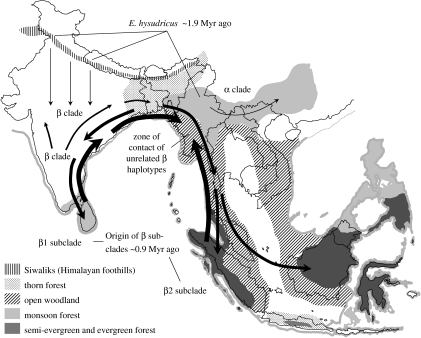Figure 5.
A simplified schematic of our revised hypothesis to explain the observed distribution of mitochondrial haplotypes. Arrows of increasing thickness indicate more recent time periods. There were at least two southward migrations, the first ca 1.9 Myr ago resulting in allopatric fragmentation and, consequently, the origin of the α and β clades, and the second ca 0.9 Myr ago resulting in the origin of β1 and β2 subclades. A subsequent northward expansion gave rise to the zone of contact of unrelated β clade haplotypes in Myanmar. Palaeovegetation types during the last glacial maximum based on Adams & Faure (1997) and Gathorne-Hardy et al. (2002) are also shown. Monsoon forests and semi-evergreen and evergreen forests are thought to have served as Pleistocene glacial refugia.

